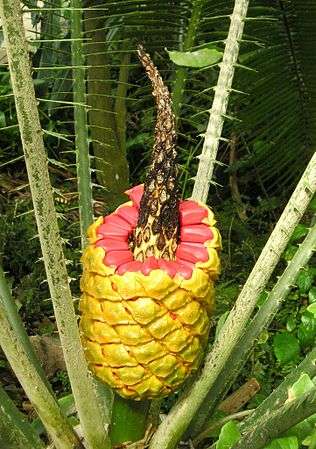Encephalartos villosus
| Encephalartos villosus | |
|---|---|
 | |
| Male cones | |
| Scientific classification | |
| Kingdom: | Plantae |
| Division: | Cycadophyta |
| Class: | Cycadopsida |
| Order: | Cycadales |
| Family: | Zamiaceae |
| Genus: | Encephalartos |
| Species: | E. villosus |
| Binomial name | |
| Encephalartos villosus Lem. | |
Encephalartos villosus is a South African cycad occurring from the East London vicinity, where it is found near the coast, to the northern border of Swaziland where it may grow as far as 100 km inland. The species is common throughout its range and is the most frequently cultivated in Southern Africa, largely because of its affordable price. As a result of its large geographical distribution, it is notably variable in leaf and cone shape.
A largely underground trunk results in very little of the plant being visible, so that it is described as a dwarf species. The preferred habitat of this species is frost-free coastal bush. It hybridises readily with Encephalartos altensteinii in the Eastern Cape and with Encephalartos lebomboensis in the Pongola area.
The crown normally consists of tightly-packed bracts covered in dense grey woolly hair (villosus = hairy). As with all cycads this species is dioecious. Male plants may carry up to 15 cones, whereas only one or two occur on the females. The seeds, embedded in bright-red flesh are eaten and distributed by the purple-crested lourie (Tauraco porphyreolophus) and by the trumpeter hornbill (Bycanistes bucinator).[2]
Gallery

Female cone 
Seeds in female cone
References
- ↑ Donaldson, J.S. (2009). "Encephalartos villosus ". IUCN Red List of Threatened Species. Version 2015.3. International Union for Conservation of Nature. Retrieved 15 November 2015.
- ↑ Douglas Goode - Cycads of Africa - Struik Wincester 1989
External links
![]() Media related to Encephalartos villosus at Wikimedia Commons
Media related to Encephalartos villosus at Wikimedia Commons
